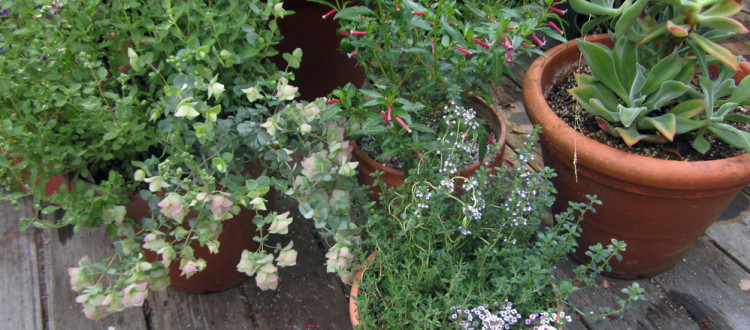Getting Started with Container Gardening
Container gardening is a simple yet rewarding way to grow plants that produce food, flowers, or foliage. There are a few guidelines to follow to ensure your container garden will be productive throughout the growing season, so here’s an overview about what you need to create your own container garden!
Containers
Deciding on what kind of containers to use is the first consideration. The good news is: there are no hard and fast rules! From ornate Italian clay pots to used five-gallon containers, the choice is up to you. Make certain that whatever container you use has drainage capability and that the inside is clean. If you’re using a plastic bucket, drill a few holes in the bottom to allow for drainage.
Whatever type of container you select, it’s a good idea to put something over the holes in the bottom to keep the soil from leaking out. Paper towels, coffee filters, even old window screens are effective.
Make sure the container has some space between the surface it sits on and the bottom of the container. This will help prevent wood rot if it’s sitting on your deck, and will ensure drainage from any container has a place to go if it’s on a cement surface.
Soil Mix
A successful container garden requires good, fertile soil that has a lot of holes that allow air, water and roots to pass through it easily. Plants use their root system to assimilate the nutrients required to grow. Soil that is too tightly packed prevents this from happening. It is vitally important to create a soil blend that is loose as well as fertile. Here are some tips for creating a good soil mix for your containers.
- Use mature compost to provide the necessary microbial activity plants need to thrive. Packaged soil mixes at nurseries and garden centers can vary in the quality of ingredients. Mixing in compost with any soil mix you use helps to ensure you’ll be using a soil mix that is alive with nutrients.
- Add soil nutrients, since most soil mixes do not contain them. Even the soils that do have nutrients when you buy them, you’ll need to add nutrients as the growing season progresses. Granular slow release fertilizers with mycorrhizal inoculants provide optimal results and should be added on a regular basis throughout the growing season. Be sure to follow recommended rates of applications.
- The soil in containers tends to become compacted as the season progresses. Adding sphagnum peat, vermiculite or perlite, and limestone will help keep the soil loose.
Choose the Right Sized Container
Planting a palm tree in a coffee can or twigs of rosemary in a 55-gallon drum are exaggerated examples of bad container decisions. The size of container should match not only the area in which it will be placed, but also should accommodate what you want to grow. Determine how big the plants will grow and decide if the container will hold it.
Water Properly
The type of container you use has a great deal to do with how often you need to water it. Clay pots evaporate water relatively quickly, while a plastic bucket or glazed pot will hold moisture in. It’s just as easy to over-water as underwater. To check moisture levels in your pot, push your finger into the soil an inch or two. If it’s dry, you need to add more water. If it’s still moist, check it again in a day or so. Always be sure to water evenly and on a regular basis.
Select Plants that are Suitable for the Site
If the site for your container is in full sun or shade, choose a plant that will thrive in that particular location. If you have a small space, avoid plants that will outgrow the area.
Follow these simple steps and you’ll have a container garden that is robust and pleasing to the eye.
RESOURCES:
Here are some resources in Northern California that offer a wide selection of containers and pots, soil mixes, and of course, plants!

